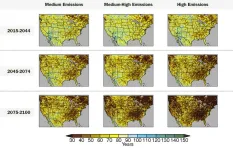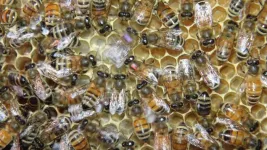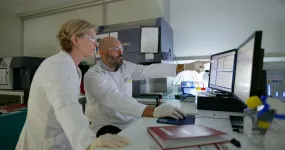(Press-News.org) Wildfires. Many see them as purely destructive forces, disasters that blaze through a landscape, charring everything in their paths. But a study published in the journal Ecology Letters reminds us that wildfires are also generative forces, spurring biodiversity in their wakes.
“There’s a fair amount of biodiversity research on fire and plants,” said Max Moritz, a wildfire specialist with UC CooperativeExtension who is based at UC Santa Barbara’s Bren School of Environmental Science & Management, and is the study’s lead author. Research has shown that in ecosystems where fire is a natural and regular occurrence, there can be more species of plants — a greater “species richness” — due to a variety of factors, including fire-related adaptations. But, he said, there hasn’t been nearly as much research in the way of animal biodiversity and fire.
“If you look at how fire operates across the planet, fire actually eats plant productivity,” Moritz said. Productivity, which is a measure of how quickly biomass is generated within a given ecosystem, is also a driver of species richness at broad spatial scales. “When fires occur they can take a bite out of that bottom line,” he added.
If fire regularly consumes some of the base of an ecosystem’s food chain, how does that ripple up to affect the biodiversity at higher levels?
That was the question Moritz investigated during a project supported by UC Santa Barbara’s National Center for Ecological Analysis & Synthesis; he later recruited collaborators Enric Batllori from Universitat de Barcelona and Benjamin M. Bolker from McMaster University in Canada. For several years they combed through global datasets on various factors such as plant biomass, fire observations and species richness patterns.
While it might be natural to assume that plant biomass regularly consumed by fire would in turn lead to lower animal biodiversity, they found that for birds and mammals, fire is associated with increased diversity. In fact, they say, the effect of fire on biodiversity in the case of birds rivals that of the ecosystem’s productivity. And in the case of mammals, fire’s influence was even stronger than that of productivity.
“It’s counterintuitive,” Moritz said. In the short term, fire’s consumption of plant material (also known as “net primary productivity”) could result in less food for the animals that consume plants and make it more difficult to survive and reproduce. But in the longer term, he said, there may be evolutionary effects that unleash adaptations and formations of new species.
The researchers also looked at the effect of fire on amphibian species, however, the connection between fire and biodiversity in their case was difficult to make, possibly because amphibians live in wetter environments where fires may not be a regular occurrence.
So what accounts for the net positive effects of fire on mammal and bird diversity? The study is a correlative one, Moritz said, so more granular examinations have to be made to find out for sure. But it’s likely that fire selects for species that can adapt to and quickly recover from a burn, and fire often creates environmentally complex habitats that meet different species’ requirements.
“We know that fire creates a lot of heterogeneity and opens up all these niches,” Moritz said, and this resource availability might create favorable environments for some organisms to flourish alongside or over others. For example, animals that have strategies to survive fires or reproduce faster might do better in a fire-prone environment, as could those that make use of different habitats that emerge in the wake of a blaze.
Despite the connection between fire and species richness, the authors are careful to point out it does not mean fire is good for all ecosystems. In places where fire is not a natural occurrence, its presence “is more of a modern threat than an important process to maintain,” they said. And for places where fire is a natural part of the ecosystem, climate change-driven and intentional deforestation fires “may be quite different from natural fire regimes.”
Nevertheless, they say, these findings indicate that fire plays an underappreciated role in the generation of animal species richness and biodiversity conservation. Furthermore, the study adds nuance to the Latitudinal Biodiversity Gradient, a global pattern of terrestrial biodiversity in which the world’s most biodiverse areas are located nearest to the equator, with levels of biodiversity generally decreasing toward the poles.
“This is a pattern that people have known for decades and have argued quite a bit about in terms of what drives it,” Moritz said. “And it turns out, it’s hard to figure out. And it looks like fire plays a far more important role than we’ve ever really understood.”
END
Wildfires and animal biodiversity
Naturally fire-prone ecosystems tend to have more species of birds and mammals, new study reveals
2023-04-13
ELSE PRESS RELEASES FROM THIS DATE:
New look at climate data shows substantially wetter rain and snow days ahead
2023-04-13
A key source of information underpinning the upcoming National Climate Assessment suggests that heavy precipitation days historically experienced once in a century by Americans could in the future be experienced on several occasions in a lifetime.
Scientists at Scripps Institution of Oceanography at UC San Diego and the Department of Energy’s Lawrence Berkeley National Laboratory (Berkeley Lab) report that extremely intense days of rain or snow will be more frequent by the end of this century than previously thought ...
Manchester graphene spin-out signs $1billion game-changing deal to help tackle global sustainability challenges
2023-04-13
A spin-out company from the graphene innovation ecosystem at The University of Manchester has formed an international partnership that will spearhead an unprecedented scale-up of graphene-based technologies intended “to make a substantial impact on global CO2 emissions”.
UK-based Graphene Innovations Manchester Ltd (GIM), founded by University of Mancheser graduate Dr Vivek Koncherry, has signed a Memorandum of Understanding (MoU) with Quazar Investment Company to create a new company in the UAE. Graphene innovation has "
This agreement - ...
Will ChatGPT replace computational materials scientists?
2023-04-13
“ChatGPT is a very impressive tool,” said paper author Zijian Hong, professor at the School of Materials Science and Engineering, Zhejiang University, China. “As a computational materials scientist, I’m always eager to embrace new tools, in particular, new tools in computer science and AI. Since the born of the new ChatGPT, I’m just wondering whether such a tool can assist us in computational materials science”
Hong explained that for a computational materials task, there are three main steps: building a model or a structure, writing ...
Towards a deeper understanding of turbulence in elastoviscoplastic fluids
2023-04-13
Three-dimensional simulations shed light on how energy dissipates within non-Newtonian fluids (fluids in which viscosity depend on the shear rate.) The result is valuable in the context of disaster forecast and management or industrial production.
Elastoviscoplastic (EVP) fluids like mud, concrete, and lava are a type of non-Newtonian fluid that exhibit both solid and fluid-like behavior depending on the forces they are subjected to (i.e., applied stress). Their flow behavior is more complex than that of Newtonian fluids, such as water and air, which have a constant viscosity. In a recent study, researchers ...
Stop signals reduce dopamine levels and dancing in honeybees
2023-04-13
Researchers from the Xishuangbanna Tropical Botanical Garden (XTBG) of the Chinese Academy of Sciences and the University of California San Diego have revealed that receiving an inhibitory signal (stop signal) associated with negative food conditions can decrease brain dopamine levels in dancing honeybees.
The study was published in Current Biology on April 13.
Dopamine is known as the feel-good neurotransmitter—a chemical that ferries information between neurons. In multiple animals, dopamine is involved in arousal, cognition, and sensitivity to stimuli. It is also associated with seeking and wanting behavior, particularly ...
Health care–associated infections among hospitalized patients with vs without COVID-19
2023-04-13
About The Study: In this analysis of more than 5 million hospitalizations between 2020 and 2022, health care–associated infection (HAI) occurrence among inpatients without COVID-19 was similar to that during 2019 despite additional pressures for infection control and health care professionals. The findings suggest that patients with COVID-19 may be more susceptible to HAIs and may require additional prevention measures.
Authors: Kenneth E. Sands, M.D., M.P.H., of HCA Healthcare in Nashville, is the corresponding author.
To access the embargoed study: Visit our For The Media website at this link https://media.jamanetwork.com/
(doi:10.1001/jamanetworkopen.2023.8059)
Editor’s ...
Risk of new retinal vascular occlusion after mRNA COVID-19 vaccination
2023-04-13
About The Study: The findings of this study including more than 3 million patients receiving the mRNA COVID-19 vaccine suggest that retinal vascular occlusion (RVO) diagnosed acutely after vaccination occurs extremely rarely at rates similar to those of two different historically used vaccinations, the influenza and tetanus, diphtheria, pertussis (Tdap) vaccines. No evidence suggesting an association between the mRNA COVID-19 vaccination and newly diagnosed RVO was found.
Authors: Rishi P. Singh, M.D., of ...
[EMBARGOED] The 2020 election saw fewer people clicking on misinformation websites, Stanford study finds
2023-04-13
In the run-up to the 2020 election, people appear to have become savvier in spotting misinformation online: clicks onto unreliable websites have declined, according to a new Stanford study published April 13 in the journal Nature Human Behaviour. According to prior research, some 44.3 percent of Americans visited websites during the 2016 U.S. election that repeatedly made false or misleading information.
During the 2020 election, Stanford scholars saw that number drop by nearly half to 26.2 percent.
While these findings ...
Curtin researchers map genetic signature of precursor to liver cancer
2023-04-13
Researchers at Curtin University have identified the genetic signature of pre-malignant liver cells, offering potentially significant implications for the almost 3,000 Australians diagnosed with the deadly cancer each year.
The study, published in the prestigious journal Cell Genomics, found that quantifying pre-malignant liver cells in patients with liver disease could help determine their future risk of developing liver cancer.
First author Dr Rodrigo Carlessi, from the Curtin Medical School and the Curtin Health Innovation Research Institute, said the discovery had the potential to save lives by changing how chronic liver disease patients ...
One brain, multiple and simultaneous alternative decision strategies
2023-04-13
Choosing a checkout line in a supermarket might seem like a no-brainer, but it can actually involve a complex series of cerebral computations. Maybe you count the number of shoppers in each line and pick the shortest, or estimate the number of items on each conveyor belt. Perhaps you quickly weigh up both shoppers and items and maybe even the apparent speed of the cashier... In fact, there are a multiplicity of strategies for solving this problem.
So how does the brain know how to make decisions ...
LAST 30 PRESS RELEASES:
Scientists boost cell "powerhouses" to burn more calories
Automatic label checking: The missing step in making reliable medical AI
Low daily alcohol intake linked to 50% heightened mouth cancer risk in India
American Meteorological Society announces Rick Spinrad as 2026 President-Elect
Biomass-based carbon capture spotlighted in newly released global climate webinar recording
Illuminating invisible nano pollutants: advanced bioimaging tracks the full journey of emerging nanoscale contaminants in living systems
How does age affect recovery from spinal cord injury?
Novel AI tool offers prognosis for patients with head and neck cancer
Fathers’ microplastic exposure tied to their children’s metabolic problems
Research validates laboratory model for studying high-grade serous ovarian cancer
SIR 2026 delivers transformative breakthroughs in minimally invasive medicine to improve patient care
Stem Cell Reports most downloaded papers of 2025 highlight the breadth and impact of stem cell research
Oxford-led study estimates NHS spends around 3% of its primary and secondary care budget on the health impacts of heat and cold in England
A researcher’s long quest leads to a smart composite breakthrough
Urban wild bees act as “microbial sensors” of city health.
New study finds where you live affects recovery after a hip fracture
Forecasting the impact of fully automated vehicle adoption on US road traffic injuries
Alcohol-related hospitalizations from 2016 to 2022
Semaglutide and hospitalizations in patients with obesity and established cardiovascular disease
Researchers ‘listen in’ to embryo-mother interactions during implantation using a culture system replicating the womb lining
How changing your diet could help save the world
How to make AI truly scalable and reliable for real-time traffic assignment?
Beyond fragmented markets: A new framework for efficient and stable ride-pooling
Can shape priors make road perception more reliable for autonomous driving?
AI tracks nearly 100 years of aging research, revealing key trends and gaps
Innovative techniques enable Italy’s first imaging of individual trapped atoms
KIER successfully develops Korea-made “calibration thermoelectric module” for measuring thermoelectric device performance
Diversifying US Midwest farming for stability and resilience
Emphasizing immigrants’ deservingness shifts attitudes
Japanese eels, climate change, and river temperature
[Press-News.org] Wildfires and animal biodiversityNaturally fire-prone ecosystems tend to have more species of birds and mammals, new study reveals





